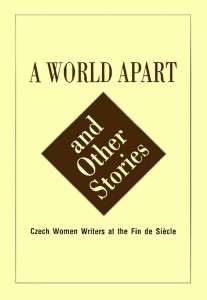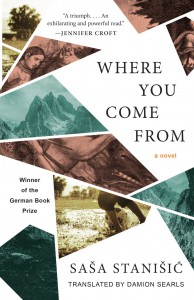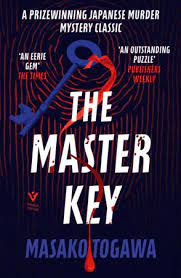This month, our selections of the best in global literature present a bevy of questions to be answered—rectifying the neglect of Czech women’s writing at the end of the twentieth century, solving murders, and chasing that ever-wandering place of home. Read on for these pivotal texts that are taking place amidst the most sustaining inquiries of our time: of secrets, of memory, and of desire.

A World Apart and Other Stories by Various Authors, translated from the Czech by Kathleen Hayes, University of Chicago Press, 2021
Review by Maddy Robinson, Social Media Manager
Kathleen Hayes’s collection of fin-de-siècle Czech women’s writing, A World Apart and Other Stories, is to be granted a second edition—twenty years after its initial publication, and around a century after the heyday of its writers. As Hayes informs us in her introduction, despite the proliferation of women’s writing in Czech literary magazines and anthologies at the time, or the academic attention the period has received, there continues to be a distinct lack of English translations for feminine texts from the turn of the century. In an effort to combat this dearth of material, Hayes carefully selected and translated eight short stories written before the First World War, to offer English language readers entry into a literary movement that might otherwise have remained solely within the domain of Central European Studies academics. We are presented with invaluable insight into the societal and individual concerns which accompanied this turbulent period in history, especially viewed in the context of a people struggling with “the woman question.”
The book opens with Božena Benešová’s “Friends,” an evocative tale of childhood sensitivity to perceived social hierarchies, and a frank condemnation of anti-Semitism. Hayes remarks that this is rather unusual, given that “at the time it was written, negative references to the Jews were still the norm in Czech literature.” The story also constitutes an anomaly in this anthology, as from this point on, there is but one central theme around which each story revolves: passion, forbidden or otherwise.
She was a strange woman, but perhaps, after all, strange only from my point of view. I was totally incapable of getting close to her soul.
The titular story, “A World Apart,” was published in an anthology of the same name in 1909 by Růžena Jesenská and is perhaps the most striking and complex of the collection. Travelling by train, the protagonist Marta recounts the story of a friendship she once had with a Miss Teresa Elinson, an intense woman whom she also met on a train, and who convinces her to visit her manor house “A World Apart.” Miss Elinson’s attempts to seduce Marta are not initally met with outright rejection—however, there is a foreboding, Du Maurier-like sense that if she were to remain at A World Apart, she might suffer the same fate as her deceased predecessor, Berta. Though Hayes puts the unlikely subject matter of lesbian desire more down to “literary convention than psychological realism,” Jesenská’s depiction of the risks of breaking worldly norms, as well as her portrait of the passionate, Dandy-esque figure of Teresa Elinson, make for a fascinating contribution to any study of turn-of-the-century queer desire and its manifestations.
I’m a mad weakling and a flirt . . .
Flirts abound in this book. The above quotation is taken from Helena Malířová’s “The Sylph,” which is written as a series of diary entries by a lovesick twenty-three-year-old man, offering a playful subversion of narrative form in its observation of societal expectations, and what is at stake when they are challenged. Sexual morality is the order of the day, and the authors assembled here provide us with an array of perspectives on the myriad ways in which girls and women are unable to transcend their social inferiority—often with brutal consequences. In Marie Majerová’s My Friend, My Brother, we are delivered a tragic account of two sailors, whose friendship echoes that of Achilles and Patroclus (with all the homoeroticism that this implies); the purpose of this narrative, we come to realise, is to form a complex a backstory to explain the murder of a prostitute.
A strange smile appeared on her lips. “This foolish world . . .”
In her introduction, Hayes argues that the stories in this volume do not constitute ‘complaints or calls for change; rather, they are attempts to portray the dilemmas, states of mind, and fears of a variety of characters’. This is especially true in “Eva” by Gabriela Preissová, which, as one of the longer pieces in the book, takes the reader through the turbulent account of two lovers forced to conduct their ill-fated affair to the rhythms of the agricultural calendar. The cyclical nature of time experienced by the protagonists highlights the futility of the eponymous Eva’s ambition, and the inescapable reality that is her sex.
The footnotes in Hayes’s translation provide the reader with handy contemporary historical information, as well as a few intriguing translation curios. The former are most welcome, as allusions to the complex Central European politics of the time found in these stories might otherwise go unnoticed by the non-specialist reader. Those which explain translation choices are helpful too—if a little indulgent at times. However, given the lack of attention paid by translators and editors to this period of history, Hayes’s collection will undoubtedly be hailed as a pioneering step in further explorations of this unique corner of feminine writing.

Where You Come From by Saša Stanišić, translated from the German by Damion Searls, Tin House, 2021
Review by Jacqueline Leung, Editor-at-Large for Hong Kong
Born in Višegrad in 1978, Saša Stanišić was fourteen when he escaped the Bosnian war with his parents. Upon arrival in Germany, foreign and still coming of age, he searched for home—that which one knows and imagines, a place to find and leave behind. The continual inquiry of his investigations can be found in Where You Come From, translated by Damion Searls and winner of the German Book Prize. Stanišić’s third publication, it explores the author’s displacement through autofictive writing, similar to previous novels Before the Feast and How the Soldier Repairs the Gramophone, which also deal with Stanišić’s family history and lost country. Told from the perspective of a protagonist who shares the author’s name, the book dives in and out of genre expectations and chronology, blending prose with poetry and choose-your-own-adventure, historical narrative with folklore and false memories, all with the effect of conveying the difficulty of shaping identity and making self-experience coherent to others.
Where You Come From comprises mostly of fragmentary chapters that jump from one point in time to the other, and has at its core Stanišićs grandmother, Kristina, who suffers from dementia in her last years. She forgets the death of her husband, Pero, her own possessions, and the names of the people around her; the more she loses, the more Stanišić writes—but the memories are never reassembled the way they were. Try as he might, Stanišić has only partial memory of his grandfather, who he chases through transcripts and shopping lists, ephemera from the past that conjure unfulfilled longing. The rest of Višegrad, however, is a personal excavation—a site of childhood nostalgia and unspeakable tragedy, at times vividly remembered but always overshadowed by political circumstances. After the war, Stanišić finds it difficult to consider earlier moments from his life in the same carefree light: “Hardly any memory is just personal; almost every one comes with a postscript, a footnote, of perpetrators and victims and atrocities that took place there.” In a chapter titled “Lamb,” Stanišić recalls a family gathering in the May of 1990 by the Višegrad health spa—grandmother Kristina with her hair rolled up, a whole lamb roasted on a fire Stanišić accidentally kicked a ball into, his father passing him a beer for some reason. The joviality comes with a fact Stanišić simply delivers: two years later, dozens of Muslim women were raped and killed in the same location by paramilitaries as part of ethnic cleansing.
Stanišić makes frequent mention of how language builds identity—the “check marks” on his name hold him back at immigration, the teenage fear of his parents cheering in Serbo-Croatian at the basketball games of his youth. German, the language Stanišić consciously learned to write in, serves as the force behind his residence permit; he got to stay in the country because he signed a contract for his first novel, while his parents were forced to move to the United States. Writing, then, introduces structure to his life and work, but also lends itself to fictions and dreams. At one point, Stanišić accompanies Kristina to the small, rural village of Oskoruša, his grandfather’s birthplace where only thirteen people remain. As they visit family graves, Gavrilo, an old man who urges Stanišić to know his origins, tells him about the dragons his family is associated with—dragons which represent valiance and history, but also something to be slain. Gavrilo is also the one who first utters the word poskok, a horned viper of terror and folklore-turned-memory; believing his father to have killed the viper to protect him, Stanišić looks back on the incident much later in fondness, only for it to be debunked (through a series of WhatsApp messages, no less) by the hero himself.
Similarly, the novel’s final choose-your-own-adventure section takes an epic turn that is ultimately diminishing. Stanišić reimagines his trip with his grandmother to Oskoruša; in one route, they escape from her elderly home and head to the mountains, Kristina armed with a rapier, and confronts a three-headed dragon guarding a bridge that leads to Pero. With tropes of conquest and chivalry, the section suggests agency and linearity, but simultaneously collapses these inclinations with a wry awareness that all is fantasy in the end. Despite the numerous paths made available to them, death remains an undeniable truth.
Memory may be compromised and language consistently inadequate, but Where You Come From still conveys, through imperfect moments, the meaning of home—the compassion among family members, a neighbor’s friendly greeting over a fence, the patience to let other people finish their sentences. Full of wit and deeply affectionate, the novel is a memento to Stanišić’s loved ones and his own life. It approaches tragedy with all the space it is given, but maintains there are parts of the self, multifarious and perhaps contradictory, that are worthy of brilliance.

The Master Key by Masako Togawa, translated from the Japanese by Simon Grove, Pushkin Press, 2021
Review by Alyea Canada, Assistant Editor
I’m usually a very passive reader when it comes to mysteries; though I find them riveting, I rarely attempt to connect clues or guess at the ending. Yet—while reading Masako Togawa’s The Master Key, I found myself hovering over the page, furiously scribbling “a-ha!” and “the wife!” in the margins.
Togawa’s novel is a honkaku mystery, a subgenre of Japanese thrillers that can be categorized more as howdunnits than whodunnits. By leaving clues for the reader to find and piece together, it forces audience participation, and therefore a deeper level of engagement. This edition of Simon Grove’s 1986 translation, newly re-released from Pushkin Press, is a compact and wild ride, tantalizingly moving through the secret lives of the select women who populate the K Apartments for Ladies.
The Master Key wastes no time in dropping mysteries in the reader’s lap, opening with a prologue in which a man is struck and killed by a truck while a woman patiently awaits his return. After this incident, we immediately jump back three days prior to the scene of a man lugging a large suitcase into the same apartment building; the suitcase is revealed to contain the body of a child, whom the man, with a female companion, bury in the basement. As soon as that disturbing image fades, the narrative catapults forward seven years, when the women residents are awaiting the hour wherein their apartment building will be moved a few feet, in order to accommodate the expanding local highway. This rapid movement through chronology deepens the sense of anticipation; we know that moving the building will result in the body’s discovery, which will in turn set us on the path of investigating his murder—but that isn’t quite what happens. Instead, the turn of events reveal that for six months, the women have cohabited in a growing state of uneasiness after the master key—which opens all one hundred and fifty rooms in the building—suddenly disappears. The initial mysteries are then set aside for most of the novel, as the key’s loss unveils a matryoshka of secrets and crimes hidden by several of the residents.
Togawa makes excellent use of an inconsistent timeline to ratchet up the tension; events aren’t told in chronological order, but instead are put in relation to the previous chapter’s revelations. This constant shift in timeline—ordering the book along the plot’s developments instead of a traditional chronology—maintains the heightened tension. Not knowing which steps the narrative will take, or how the next woman introduced will fit into the larger story, also invites thrill into a novel that isn’t exactly action-packed. Despite its episodic nature, however, the novel does culminate in a final reveal, delivered well after the final events of the novel as an epilogue of sorts.
The Master Key is unsettling not necessarily because of the crimes embedded in its nature, but because of the undercurrent of violation throughout its pages. Nearly all of the characters are women and their lives are all subversive to various degrees; older yet single, they live on the outskirts of a Japanese society that still subscribes to traditional values.
. . . most of the residents here have at some time or another had the opportunity to lead as full lives as are open to women. Now, as they grow old and look back on the bright days of their pasts, a lot of them perversely withdraw into their shells. . . . To such old maids, their little secrets are all they have to live for, all that gives them pride, all that remains of their possessions and estate.
For these women, their apartments are where they are most free—where they can escape into their various pasts, fervidly editing their late husband’s manuscript or methodically reaching out to past students or habitually setting out food for a guest who never returns. The theft of the master key is the primary violation of that sense of freedom, and the voyeuristic act of reading violates it again. With the detailed descriptions of the women’s lives written in the perspective of the intruder, one is struck by an overwhelming sense that none of this should be seen, yet cannot help but be swept up, at the same time, into the skewed morality of the building, buying into the increasingly thin justifications for violating a neighbour’s privacy.
It makes sense that Togawa would write about subversive women; she was a feminist and queer icon in Japan who—in addition to being one of Japan’s foremost crime novelists—was also a singer, actress, and nightclub owner. She was also raised by her mother in an apartment similar to the one featured in The Master Key—although hopefully with fewer bodies. Grove’s translation is engaging, if at times a bit formal, and despite the relatively simple and plain language you can sense in it a new writer finding her style, The Master Key is an engaging—if unsettling—peek into the secret lives of women supposedly past their prime, a brilliant reminder that you never really know even those living closest to you, and that secrets never stay buried. Whether motivated by loneliness or nosiness, eventually everything is forced into the light.
*****
Read more on the Asymptote blog:

